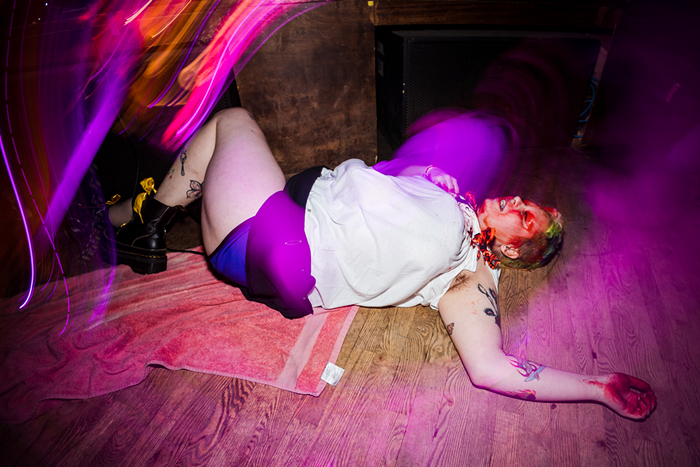Can ghosts haunt ghosts? In Heather Dew Oaksen's installation Still Point (through Thurs Feb 12, Jack Straw Productions, Mon–Fri 9 am–5 pm, free), projected figures loom beside and behind each other in darkness. Faces and silhouettes hung as tapestries undulate like Byzantine icons, distilling depth from wavering light and bodies, which though seemingly frozen can't keep still. A succession of ordinary people appears: All are young and blank and, eerily, easily forgotten. Faces split into diptychs, then echo backward in the room. Many stare ahead or into the distance; a few turn around and walk away. Most try to talk or to sing, a futile choir sounding too translucent to join the installation's enveloping chorus of cicadas and the hum of what might be outlying freeway traffic.
Amid Still Point's wall of sound, a keening tone rises and falls; akin to feedback, it's the only sound that breathes, tracing and following the images as they vanish and reappear.
Oaksen's installation feels compressed, cramped even. Unlike the grand corridor of Gary Hill's Tall Ships—an unforgettable gallery of azure phantoms who stand, shuffle, and recede into the distance—Still Point battens in the viewer. Feeling cornered, I do my best to look straight ahead down a narrow pathway that bisects the hanging scrims, but overarching darkness confuses any sense of perspective. There's an utterly ambiguous sense of dimension.
In 1968, Konstantin Raudive published the book Breakthrough: An Amazing Experiment in Electronic Communication with the Dead, the summation of thousands of hours of recordings in which, through shrouds of static and fuzz, words from the dead—dubbed "Electronic Voice Phenomena"—could supposedly be discerned. As heard on The Ghost Orchid: An Introduction to EVP (Ash International), which collates examples from three EVP researchers active in the 1960s and '70s, including Raudive, Freidrich Jürgenson, and Raymond Cass, it's hard to confirm communication from beyond with garbled, gnomic utterances such as "Only Sonja will make it" and "We can see Edith by radio." The DIY séances presented by Raudive and company as "evidence" still hinge on interference and the listener's desire to believe.
Still Point fascinates not through the prospect of a personal revelation, but in the relationships between the spectral bodies we see haunt one another. Still Point is a séance for ghosts and we get to watch. Don't miss it.
Other notable performances this week include pianist Ann Cummings (Sat Feb 7, Chapel Performance Space, 8 pm, $10/$15), who performs works by Brahms, Debussy, and Copland alongside Seattle composers Richard Karpen, Gavin Borchert, and Ken Benshoof. The fine improvising percussionist Tatsuya Nakatani accompanies Butoh dance company Danse Perdue (Sun, Feb 8, Rendezvous, 10 pm, $5–$15). The doctoral recital of bassist Bren Plummer (Thurs Feb 5, Brechemin Auditorium, UW Campus, 7:30 pm, free) serves up music by Schumann and Webern as well as his funky jazz combo, the Paradigm Quartet. ![]()


















